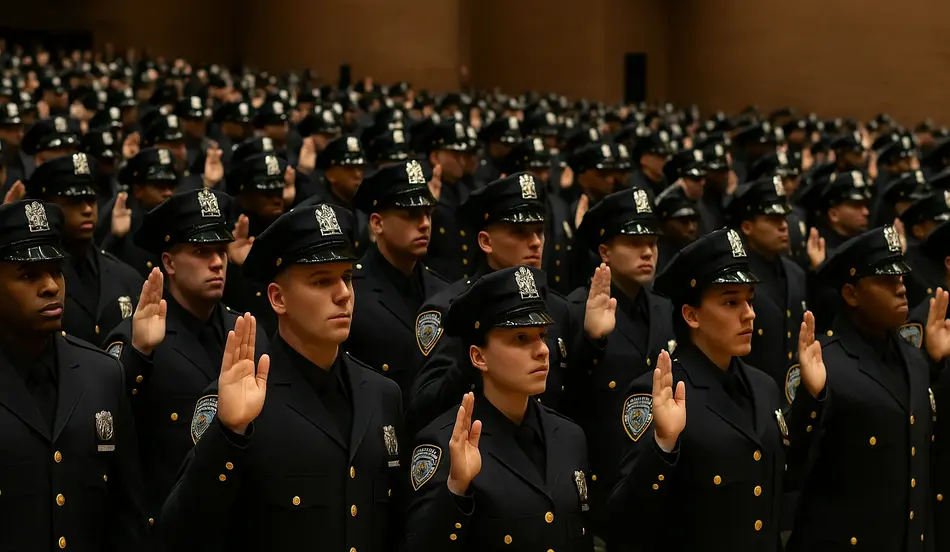For years, the New York Police Department (NYPD) has wrestled with staffing shortages, declining applicant numbers, and questions about morale and public trust. But this week, the department celebrated a turning point: the induction of 1,093 new officers, its largest recruit class in nearly a decade.
It is more than a number. This milestone signals a renewed investment in the city’s safety, a shift in recruitment policy, and a recognition that the department must adapt to attract a new generation of officers.
The Recruitment Challenge
A Decade of Decline
From 2017 to 2023, NYPD recruitment suffered a steep drop. Applications fell by more than 55% in that span, slipping from around 18,000 to barely 8,000. The pandemic worsened the crisis, with rising retirements and resignations outpacing new hires.
Several factors contributed:
- Workload & Stress: Officers cited long shifts, high-stress conditions, and public scrutiny.
- Pay Gaps: Many left for suburban or private security jobs with better compensation.
- Trust & Perception: Recruiting young talent became harder as policing faced cultural and political debates.
By 2022, officials warned that if the trend continued, the NYPD could fall below operational safety thresholds, undermining community policing efforts.
New Recruitment Strategy: A Reset
Monthly Exams for Accessibility
Traditionally, police exams were held only a few times a year, restricting opportunities. The department now runs monthly exams, creating rolling entry points and reducing the waiting period between application and academy acceptance.
Credit Requirements Reduced
The previous 60-credit college requirement excluded many capable applicants. By lowering the threshold to 24 credits and offering 45 credits for academy training, the NYPD has positioned itself as both a career path and an educational ladder.
Expanding the Talent Pool
This change opened the door for thousands of working-class and first-generation candidates who may not have had the financial means to complete a two-year degree before applying. The policy shift also made the force more reflective of the city it serves.
Social Media and Outreach
Recognizing that younger generations connect online, the NYPD broadened its recruitment through TikTok, Instagram, and targeted campaigns. Stories highlighting diverse officers—immigrants, women, and bilingual recruits—resonated strongly.
Expand Your Talent Pool
Post your job on WhatJobs and connect with diverse, motivated candidates—just like the NYPD’s new strategy, reach talent through accessibility, education, and modern outreach.
Post a Job Now →Diversity at the Core
The 2025 graduating class reflects the city’s global character:
- 25% of recruits were born abroad.
- Recruits represent 41 different nations.
- Collectively, they speak 39 languages.
This diversity is not symbolic; it’s strategic. In a city where over 180 languages are spoken, a linguistically and culturally varied police force strengthens trust and community engagement. Commissioner Jessica Tisch noted, “Our new officers mirror the neighborhoods they will serve.”
Numbers vs. Retention
The Attrition Challenge
Despite the new recruits, attrition remains a major hurdle. The NYPD is losing an average of 316 officers per month. Retirements, resignations, and transfers continue to erode gains. Without parallel investments in retention policies, the department risks a revolving door.
Pay and Morale
Union leaders point to salary disparities. While base pay starts around $58,000, comparable suburban departments offer higher wages with lower cost of living and less demanding workloads. Many NYPD officers, after gaining experience, leave for smaller departments.
Training and Culture
Retention is not only about money. A culture of support, mentorship, and career progression is needed to keep officers engaged. Without addressing burnout and stress, recruitment wins may prove temporary.
The Bigger Picture: NYPD Headcount Goals
Currently, the department stands at 33,172 officers. Mayor Eric Adams has set a target of 35,000 by late 2026. Hitting that benchmark requires not just onboarding but maintaining net growth.
If attrition continues at current rates, the NYPD must recruit at least 4,000–5,000 officers over the next 18 months just to meet its goals. That is a tall order, even with expanded outreach.
Community Expectations
Public opinion remains divided. Supporters of the expansion argue that more officers mean safer streets, faster response times, and stronger community policing. Critics caution that simply adding numbers won’t address issues of accountability, training, and relationships between police and marginalized communities.
For the NYPD, this class represents not just manpower but a symbolic moment to reset its relationship with New Yorkers. Whether through transparency, improved training, or deeper community partnerships, the department faces a defining test.
Expand Your Talent Pool
Post your job on WhatJobs and connect with diverse, motivated candidates—just like the NYPD’s new strategy, reach talent through accessibility, education, and modern outreach.
Post a Job Now →Historical Context
The NYPD’s ranks have fluctuated in response to political, social, and economic pressures:
- 1990s Boom: The “Safe Streets, Safe City” initiative boosted the force to record levels amid crime surges.
- Post-9/11 Era: Homeland security concerns fueled another expansion.
- 2010s Decline: Budget cuts, rising retirements, and shifting perceptions of policing led to contraction.
- 2020s Reset: Today’s surge mirrors past cycles but comes with new challenges—changing demographics, technology, and cultural expectations.
Future of Policing: Beyond Boots on the Ground
Experts note that simply adding officers won’t fully solve modern urban challenges. The future of policing will require:
- Technology Integration: Drones, body cameras, and AI-based data tools to enhance transparency and efficiency.
- Community Engagement: Building trust through neighborhood-based initiatives.
- Flexible Training Models: Training recruits to address not just crime but mental health crises, homelessness, and cybercrime.
FAQs
Q1: How many officers does the NYPD ultimately want?
Mayor Adams has set a target of 35,000 uniformed officers by late 2026, up from about 33,172 today.
Q2: Why did recruitment numbers fall so sharply in past years?
Declines were driven by high stress, public scrutiny, better pay in suburban forces, and pandemic-era burnout. Applications dropped by more than half between 2017 and 2023.
Q3: How is the NYPD improving diversity?
By reducing barriers like college credit requirements and highlighting stories of diverse officers, the NYPD is attracting candidates from immigrant, multilingual, and underrepresented communities.
Q4: Will this solve New York’s public safety concerns?
The influx helps, but experts stress that policing today requires more than numbers—it also needs cultural reform, retention strategies, and community trust-building.
Conclusion
The induction of the NYPD’s largest class in nearly a decade is more than a hiring statistic—it’s a reflection of the city’s evolving priorities and the department’s attempt to rebuild both its workforce and its relationship with the public.
While the milestone provides hope, the true test lies ahead: can the NYPD keep these officers long enough, support them adequately, and equip them to serve a city as complex as New York?
The answer will shape not only the department’s future but also the safety and trust of millions of New Yorkers.




